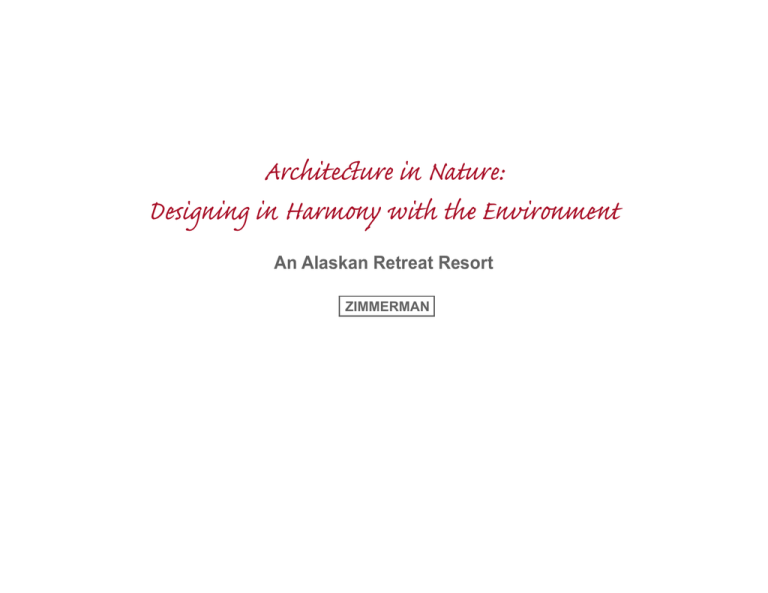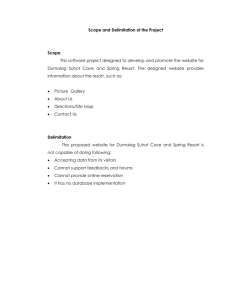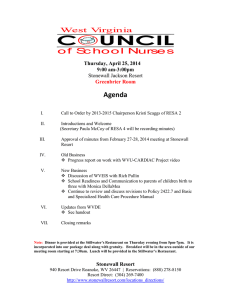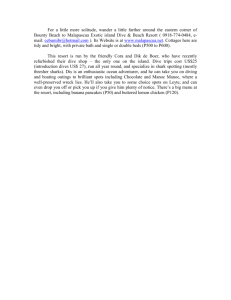Architect ure in Nature: Des igning in Harmony with the Environment ZIMMERMAN
advertisement

Architecture in Nature: Designing in Harmony with the Environment An Alaskan Retreat Resort ZIMMERMAN Architecture in Nature: Designing in Harmony with the Environment An Alaskan Retreat Resort Nicholas Zimmerman Jack Wyman, Design Professor Dan Woodfin, Departmental Advisor Department of Architecture Design Thesis College of Architecture and Planning Ball State University 2004 - 2005 Abstract Designing in Harmony with the Environment With undisturbed natural land becoming more and more scarce, it is increasingly important to design structures so that they work with the environment to ensure that the beauty of Nature may still be enjoyed by all. Designing in harmony with the environment leaves the land relatively untouched, uses renewable energy systems, and offers a visual connection to the land. To test this theory, a retreat resort in central Alaska has been designed. The intention for this resort is to show that a harmonious relationship between the built environment and the natural environment can be achieved. What differs with this resort from many other examples that have tested this theory in the past is that the resort in Alaska is intended to have a contemporary feel with modern comforts instead of just being another log cabin in the woods. The purpose of this thesis is to show that it is quite possible for contemporary structures to work just as well with the environment as those that are rustic. The resort is intended to serve as a weekend retreat for couples, or as a temporary home for environmentalists and artists (painters, musicians, authors, etc.). The remoteness from society and the beautiful natural setting of the resort justifies its use for these purposes. The resort will serve approximately 40 to 52 people at a time and will include a Main Structure that will be open year-round and Satellite Structures that offer a minimum of technological equipment that will be open on a flexible peruse schedule. The structures on the site use wind and water power for electricity, operable windows as the only cooling equipment, collected snow and window coverings to help with insulation, and composting toilets for human waste to name only a few of the ways in which the design works with its site. The Satellite Structures collect rain and snow for water and all the structures respond to the large amounts of snowfall that the region receives. The client for this project could be a wealthy individual with a love for Nature who sees a long-term profit over the high initial investment. The client could also be a public entity, such as Denali National Park, located just south of the project site, which could offer the resort as an extension of the park’s services. ▲ Final Design - Main Structure Final Design - Satellite Structure ▼ Overview Section 1 Site Study Section 2 Precedence Study Section 3 Conceptual Design & Design Process Section 4 Final Design Solution Section 5 Sources & Credits Site Study Physical Context The site is centrally located in Alaska, just north of Denali National Park, and sits at an elevation 700 feet above sea level. The site stretches about 1.5 miles from north to south and about 1.25 miles from west to east. It is mostly a plateau, but does have a gradual slope to 900 feet above sea level on the southwest portion of the site. There are both open areas and patches of trees on the site as well as a pond approximately 300 feet long by 200 feet wide. There is presumably a fair amount of undisturbed plants and wildlife on the site. The site has an average temperature ranging from negative 10˚ Fahrenheit in January to 65˚ Fahrenheit in July. The site receives annually about 12 inches of rain and about 70 inches of snow. There is a fair amount of wind coming from the north and northeast, mostly around 18 mph in the winter months and a slightly larger amount of wind coming from the southwest, mostly around 25 mph. [Note: All figures are extrapolated from the nearest climate data in Fairbanks, Alaska] ▲ General topography of region [Source: Corbis] Canoer at Denali National Park [Source: Corbis] ▼ Cultural Context While there is no existing cultural context on the site, immediately south of the site, Denali National Park attracts thousands of people annually who are in search of experiencing Alaska by backpacking, hiking trails, mountain climbing, hunting, fishing, and observing natural plant and wildlife. These park visitors are comprised not only of Alaskans, but also of people from all around the United States and the world who wish to experience the park’s beauty and recreational opportunities. It is therefore safe to say that the culture of the park is a visitor-culture composed of people with varying different cultural backgrounds. There is no evidence to suggest that there has ever been any native human settlements on the site, but there does appear to have been a few native tribes of people that may have existed around the Denali area 2,500 years ago. 1-01 ▲ Project site, summer Project site, winter ▼ Site Study 1-02 Site Study Conclusions The project site is of ample size for the small-scaled resort envisioned for it. Because of the remoteness of the site and the desire for it to be as pure and untouched as possible, vehicular traffic is not foreseen to be used or needed. If necessary, small temporary roads can be built for the delivery of construction supplies to the site, but most of the construction will likely be built off-site and air-lifted in from Denali National Park, located just south of the project site. The main ways to enter the site, therefore, will be by hiking in from Denali National Park, or by flying in by bush pilot from Denali or the nearby Fairbanks. Approaching the site in this manner will help promote the idea of being immersed in Nature and being removed from the built environment. The relative flatness of the site makes landing aircraft much easier and safer. However, hills on the other parts of the site, and trees through most of the site, will offer variety to visitors. The project site’s main assets are the views it affords and the resources it provides. These two aspects make the site particularly well-suited for the thesis project. ▲ Approach to site by small aircraft [Source: Corbis] Climatic data for the site [Source: ISMCS] ▼ 1-03 Approach to site by hiking in from Denali [Source: Corbis] ▼ ▲ Wind roses for the site [Source: NRCS] Site Study 1-04 Precedence Study Refugios del Perú This eco-tourist resort contains many of the same ideas that are envisioned for the resort in Alaska. The design for the Perú resort is a remote system with a main lodge reachable by vehicle and ancillary structures within a day’s hike. The problem of moving equipment and supplies over this distance was solved by using mules. This resort also has many contemporary amenities, such as electricity and spas. This idea of having modern elements is important to remember for the thesis site in Alaska, as such amenities yield a higher number of visitors. The resort was designed to be a destination in itself and was therefore valuable to look into on that basis as well. Exploring this project also gave insight into what type of customers would be using the Alaskan resort. ▲ Refugios del Perú [Source: Davis Partnership Architects] Halley V Research Station [Source: British Antarctic Survey] ▼ Halley V Research Station The Halley V research station, which is part of the British Antarctic Survey, serves as a base point for researchers doing climate, ice, and ozone studies. The station is broken into three separate buildings. The main building (shown at right) is a grounded structure on a raised frame to allow massive amounts of drift snow to blow under the station instead of piling up and burying the building. It is powered by diesel engines that create electricity and generate waste heat that is used to heat the buildings and to melt snow for water. The station contains bedrooms, offices, communal rooms, washrooms, a kitchen, and a hospital. The other two buildings are built on skis that allow the buildings to be pulled to different locations so they are not buried. A harsh, wintery project site like this obviously offers a great deal of knowledge for creating the resort in Alaska, which also has harsh weather conditions at times. 2-01 Birch Pond Lodge This lodge was particularly useful in its similarity to what is envisioned for the thesis resort. The Birch Pond Lodge has a climate and weather conditions very close to the thesis project site and works well. This was particularly useful in that the Birch Pond Lodge, in collaboration with Sun-Mar’s technology, were able to devise a simple method to keep composting toilets working in temperatures as cold as negative 40˚ Fahrenheit. This method merely involves making sure the bathroom is well-insulated and uses a small propane heater when necessary. Birch Pond Lodge was also rated one of the top ten eco-lodges in the world by Outside Magazine, March 2003, and is therefore instructive in environmentally-friendly design as well. ▲ Birch Pond Lodge [Source: Sun-Mar] Into the Wild [Source: Jon Krakauer] ▼ Into the Wild Jon Krakauer’s book, Into the Wild, recounts true stories of survival in harsh environments that are largely untraveled by humans. The most notable, and also the main story of the book, tells the story of a young man surviving in Alaskan wilderness, just outside the northeast end of Denali National Park. The young man idealizes the meaning of retreating into Nature and truly enjoys its beauty. He survives happily on very little, living off the land for food sustenance and seeking shelter from the harsh winter in an abandoned bus (shown at left). After surviving 100 days in the wilderness the young man falls deathly sick after accidentally eating a poisonous root. However, the essence of this book captures greatly the ideas for the thesis project in Alaska living off the land by relatively simple means and, above all, having immediate access and views to the beauty of Nature. Precedence Study 2-02 Conceptual Design & Design Process Initial Concepts Due to the remoteness of the site in the wilderness, means of sulfsustenance and working in harmony with Nature held a crucial role in the early design process. Three concepts evolved from this: responding to the climate, employing alternative energy, and minimally impacting the site. Responding to the Climate This concept principally drove ideas that would help the structures on the site survive harsh winter weather. The techniques used were to half-submerge the structures in the ground to make use of the thermal insulation that the ground and snow would provide. This concept also used a curved roof structure to better utilize the heat inside the structure and deflect the snow on the roof. This concept placed heat-generating spaces, such as the laundry room, mechanical room, and kitchen on the lower level so the heat generated from these spaces would rise to the areas above. In other sketches, responding to the climate involved elevating the structure to allow drift snow to flow under the structure so as not to bury it. Employing Alternative Energy Because the facility is entirely off of any grid, alternative means of energy are necessary to operate the building. Solar panels and wind turbines were originally envisioned for the energy supply. The photovoltaic panels would have sit atop each building to take advantage of the vast amount of daylight during the summer months. However, technical calculations done after the design process showed that this would not be a viable source of energy after all, particularly once maintenance of the photovoltaic panels was taken into account. The use of water turbines, set up at a nearby river just downhill from the project site would provide ample energy when working in conjunction with the wind turbines. Minimally Impacting the Site This was originally seen as touching lightly on the site in a figurative sense. Later it became a literal sense as well. The idea behind this concept was to keep the site as pristine as possible and letting the design blend with the site as much as possible. 3-01 ▲ Responding to the climate holistically Responding to drift and snow load specifically ▼ ▲ Wind and solar energy integrated into building Principles of energy - getting above trees and below eye sight ▼ ▲ Blending with site by sprawling organically with it Blending with site via a low profile and delicate touch on site ▼ Conceptual Design & Design Process 3-02 Conceptual Design & Design Process Integration of Concepts The three initial concepts were blended into a unified element that implemented the best aspects of each concept. Responding to the Climate The Main Structure is elevated 12 feet off of the ground in response to the high level of snowfall on the site. The vast majority of this snowfall occurs between November and February which means a lot of the snow will accumulate. The ramp, stairs, and elevator leading up to the Main Structure are designed to still be usable even after several feet of snow has accumulated at their base. The raised elevation also allows drift snow to flow under, rather than to pile on, the building. The individual buildings that comprise the Main Structure are designed to withstand heavy loads of snow over time and to use that snow as an insulator. The Satellite Structures are designed on similar principles, but since these remote structures will not all need to be accessible at all times during the year, and because the density of trees reduces drift snow, the elevated height is only 8 feet off of the ground. Employing Alternative Energy As previously mentioned, power for the site is generated by using a series of wind and water turbines. The wind turbines, located in a high, open spot to collect the most wind, also serve as markers for aircraft. Both the Main Structure and the Satellite Structures are designed to admit a good deal of natural light in to help alleviate energy demands. The summer months are warm enough to have the windows open, yet cool enough to not require an air-conditioning system. Minimally Impacting the Site The literal footprint of the design is quite small since the building is elevated on columns, which leaves as little of the environment touched by man-made structures. The horizontal nature of the Main Structure follows the horizontal element of the plateau on which the structure rests. The compact design of the Satellite Structures allow for these building to nestle discreetly into the environment. Every unit within the facility has its own composting toilet. Trash is flown out of the site by the planes that transport the visitors to the facility. 3-03 ▲ Basic layout of Main Structure with outlying Satellite Structures Satellite Structure ▼ ▲ Main Structure Conceptual Design & Design Process 3-04 Final Design Solution Program The final design consists of two main elements - the Main Structure and 12 Satellite Structures. These two elements offer different types of retreat experiences. The Main Structure is geared towards couples who want to get out in Nature and experience its breath-taking views without giving up comfort. They would typically stay at the resort for a weekend or a week. The Main Structure also offers meals prepared by the staff. The Satellite Structures, while still comfortable, are designed to be for one to two people who desire a more rugged experience. The users would cook their own food and heat the structures themselves with firewood. The Satellite Structures would typically rent out on a monthly basis to artists, environmentalists, and avid Nature lovers who wish to envelope themselves in Nature. The total number of users at a time would typically be 40-52 people, including the staff. The Main Structure itself is composed of a series of structures tied together via a connector spine, which serves as circulation and also as a vehicle for conduit and plumbing. The entire Main Structure is elevated 12 feet above ground level; this level is reached by walking up the ramp leading into the Main Building or by any of the stairs located at each structure along the spine. Upon entering the Main Building of the Main Structure, visitors will be greeted with a reception desk, which is adjacent to a communal dining hall. The Main Building contains other services for maintaining the resort as well. Also connected along the spine are 12 Guest Houses for visitors, a Staff House, and 2 Mechanical Buildings. The Mechanical Buildings contain equipment for a hot-water heating system and batteries to store excess energy generated from the wind and water turbines. By having two Mechanical Buildings instead of one, the hot-water heating system is more efficient, as the water does not have to travel as far to its destination. Near the Main Structure there is an Airplane Hanger for sheltering small planes and for storing all-terrain vehicles and other equipment. There is also a Water Tower that pulls water from the natural pond and stores it so the Main Structure has a steady supply of fresh water. Activities on the site include hiking, cross-country skiing, fishing, nature lessons, and communal gatherings. 4-01 Delineation of spaces ▲ ▲ Overall site, approximately 1.5 miles (north to south) by 1.25 miles (west to east) Final Design Solution 4-02 Final Design Solution 4-03 Main Structure nestled in its site ▲ Main Structure The Main Structure evolved into an open system from the initial closed-system design shown in the conceptual phase. The open structure places emphasis on the environment instead of a solid unit of structures. The open system also gives more flexibility in aligning views and for later expansion. Each unit on the Connector Spine has been aligned for unobstructed views of the Alaskan landscape. The series of wind turbines on a ridge adjacent to the Main Structure not only generate electricity for the structure, but also serve as a landmark for pilots landing aircraft on the site. ▲ Site plan of Main Structure Response of Main Building to the environment ▼ Site Placement The Main Structure is placed on the site so that it responds to the environment and works in harmony with it. The southwestern part of the immediate site, where the landing area is located, is mostly open and flat. This allows summer breezes to easily flow to the structure. Evaporative cooling off of the pond is employed to keep the Main Building cooler. This helps alleviate heat generated from the kitchen, laundry room, and dining area. Cold winter winds are blocked by dense forest and a natural ridge. At the top of the ridge, the wind turbines take advantage of both summer and winter winds. The proximity to the existing natural pond gives ready access to fresh water. Final Design Solution 4-04 Final Design Solution Main Building This part of the Main Structure houses both public and service areas for the resort. The entrance into the resort is made here by using a gradual ramp. This ramp ensures that everyone enters the building in the same, carefree manner instead of brusquely sidestepping the experience with a stair. The Main Building, along with all the other units along the Connector Spine, is geared to respond to the environment and maximize the experience of natural views. For instance, the low pitch of the roof and the fins on the side of the units collect snow to use as insulation in the wintertime. The large windows afford many views of the surrounding landscape and admit plenty of daylight in the summer. ▲ Interior rendering of reception desk and communal dining South elevation of Main Building ▼ 4-05 ▲ Main entrance of Main Building Final Design Solution 4-06 Final Design Solution 4-07 ▲ Floor plan of Main Building Final Design Solution 4-08 Final Design Solution Guest Housing These units employ the same environmental responses as the Main Building. However, they have a slightly different floor plan that emphasizes a wider angle for seeing more of the Alaskan landscape. The interior of the units are designed to be clean, simple, and open so the visitor’s focus is outward towards Nature. This openness is achieved through high ceilings that slope towards the windows. The room also remains visually uncluttered, with the only furniture being a bed platform with drawers underneath and a table with chairs. The Guest Houses are designed so the visitors may view Alaska from the balcony, the bed, and even the bathroom. The deep overhang creates a glareless view through the windows so the landscape is always clearly visible. ▲ Openness and simplicity of interior focuses views to outside Front of Guest Housing, typical ▼ 4-09 Rear of Guest Housing, showing connection to spine, typical ▼ ▲ South elevation of Guest House, typical Final Design Solution 4-10 Final Design Solution 4-11 Floor plan of Guest Housing, typical ▲ ▲ Interior rendering emphasizing clear, open, glareless views to the exterior Final Design Solution 4-12 Final Design Solution Other Elements of Main Structure Staff Housing This unit is designed to accommodate up to four employees. It is likely that the staff will be predominantly young adults, particularly college students wanting summer employment in Alaska. Mechanical Buildings The two mechanical units house all the equipment necessary to heat the Main Structure and batteries to store excess power. The mechanical buildings are relatively small, as they do not house any cooling equipment. All buildings on the site have operable windows, which provide ample cooling in this climate. Connector Spine The spine ties all the units of the Main Structure together. This corridor is an unconditioned space that basically serves as a wind breaker and as a transitional element from outside to inside. ▲ Front of Staff Housing Key plans for the Staff Housing, Mechanical Buildings, and Spine ▼ 4-13 Rear of Staff Housing ▼ ▲ Floor plan of Staff Housing Final Design Solution 4-14 Final Design Solution ▲ Front of Mechanical Building, typical Rear of Mechanical Building, typical ▼ 4-15 Floor plan of Mechanical Building, typical ▲ ▲ Connector Spine, showing condition adjacent to buildings and condition not adjacent to buildings Final Design Solution 4-16 Final Design Solution Satellite Structures These structures are remote units scattered within about a mile radius of the Main Structure. They therefore have a slightly different microclimate to respond to than the Main Structure. The Satellites do not have access to the pond for a steady source of water, so rainwater collection and storage is implemented. The snow shelves used for adding insulation to the Main Structure do not show up in the design of the Satellites due to the fact that the trees offer a good deal of wind protection and this design allows for windows on all sides of the units. The units are spatially compact to allow for better heating and the windows have counter-weighted insulation panels that slide over the windows to keep heat in during the cooler months. The wood stove uses local trees as a heating source for these units, but to keep the environment in tact long-term, new trees are planted to replace those cut down. The heat from the stove is also used to heat water for the shower. Waste heat from the stove melts snow on the roof for water, which is channeled back through the unit to keep it in a liquid state. ▲ Interior rendering of Satellite Structure Water usage, collection, and storage calculations ▼ 4-17 Treetop view of Satellite Structure in typical clearing ▼ ▲ Walking up path towards one of twelve remote Satellite Structures Final Design Solution 4-18 Final Design Solution 4-19 Floor plan of Satellite Structure, typical ▲ ▲ Interior of Satellite Structure, showing the living space and the bathroom beyond Final Design Solution 4-20 Final Design Solution Conclusions Further Development The design is a contemporary solution and yet works with the environment in a variety of ways. Elevated on columns, the design touches the ground lightly, leaving indigenous plants and grasses more in tact. The structures read as modern, but their relatively low, horizontal profile allow them to nestle into the environment instead of standing out opposed to it. There are many areas where this project could be developed further. Technical and construction drawings would be the final logical step in developing the project to ensure absolute feasibility, but there are many conceptual issues that should be looked at further as well. The design responds to the climate by using structures that can hold snow on the sides and roof to use for added insulation. The raised units allow drift snow to flow naturally through the site instead of building up on the structures. Additionally, the structures are engineered with longlasting materials that can withstand the elements for many years. While the use of metal panels requires a lot of up-front energy, the long-term benefits of durability and heat retention outweigh this initial environmental waste. To minimize harm to the environment, the structures will mostly be built off-site in warehouses and the pieces can be trucked to Denali National Park and then air-lifted onto the site for final assembly. This will minimize damage to the land and the plants and animals occupying it. The design also works harmoniously with the environment by using renewable wind and water energy. Solar energy ended up not being feasible for the site due to non-ideal solar angles, large amounts of cloud coverage, the perpetual night of the winter months, and the high amount of maintenance the photovoltaic panels would have required in this climate. The placement of the design on the site allows the building to block winter winds and use summer winds. It uses composting toilets for human waste, adding to the self-sufficiency of the structures. The design also uses only natural wind for cooling and as much natural daylighting as possible. During the dark months, LED lights, which are far more efficient than their incandescent counterparts, could be used to light the interior of the structures. Finally, the designs take advantage of water on the site, either by using the natural pond or through rainwater collection. 4-21 While the design works harmoniously with nature, it is still not completely sustainable as it is. For instance, trash must still be flown out of the site. Ways for using the trash on the site could greatly enhance its own self-sustenance. The Main Structure as it is now is designed with simple interiors that draw the user’s focus to the exterior. It could also be argued, however, that the interiors could become an extension of the exterior and the same level of development and detail could be applied to them. The stairs located along the connector spine for the Main Structure also could use further development so that the architectural language is consistent with the rest of the design. The placement of the Satellite Structures on the site could be more environmentally responsive as well. Instead of being 12 identical units, they could be developed as 12 units with a language and plan that relates to the Main Structure but that respond uniquely to the slightly different microclimates in which they are located. Looking at how the Satellite Structures can change with the drastic seasons would also help the overall design. The thesis statement could be applied to a larger-scaled building with a different function. This would likely bring up new complex issues concerning the thesis statement. Final Design Summary Final Design Solution 4-22 Sources & Credits Research Precedent Studies Climatic Data International Station Meteorological Climate Summary ISMCS Compact Disc, 1995 Birch Pond Lodge Rated one of the top ten eco-lodges in the world by Outside Magazine, March 2003; uses Sun-Mar composting toilets in temperatures as low as -40˚F; 70 miles north of Anchorage, Alaska. http://www.sun-mar.com/2003/birchpondlodge.htm Environmental Performance Study Eco-Structure Magazine November/December 2004, Vol. 2 No. VI History of Near-by Area National Park Service - Gold Mining http://www.nps.gov/dena/home/historyandculture/kanhx/kantishna_ gold.htm History of Near-by Area National Park Service - Minchumina Area History http://www.nps.gov/akso/parkwise/students/referencelibrary/dena/ denali_people_land/minchumina.html Rainwater Collection Formulas & Charts Mechanical and Electrical Equipment for Buildings (MEEB) Ninth Edition Benjamin Stein and John S. Reynolds Site Map U.S. Geological Survey - Kantishna River (A-2), 1952 Bracken Map Collection - G4370 S63.G46 Site Photographs Corbis: Stock Photography and Digital Pictures http://pro.corbis.com/ Sun Angles (Azimuth & Altitude) AccuRender 3.1 Wind Rose Diagrams Natural Resources Conservation Service (NRCS) http://www.wcc.nrcs.usda.gov/climate/windrose.html 5-01 British Antarctic Survey: Halley Research Station V A structure that has withstood harsh weather conditions for 60 years. http://www.antarctica.ac.uk/ Into the Wild This book by Jon Krakauer, a recount of a true story, illuminates what it is like to survive in a harsh Alaskan wilderness. Refugios Del Perú A mountain retreat with main lodge accessible by vehicle and other services within a day’s hike. Direct correspondence with Brian Patty of Davis Partnership Architects. Faculty & Peer Assistance Software Overall Project Guidance Jack Wyman, Architecture Department Dan Woodfin, Architecture Department AccuRender 3.1 Lighting & Trees for 3D Models Still Renderings Animation Research & Site Study Direction Dave Ferguson, Center for Media Design Dan Woodfin, Architecture Department Jeff Culp, Center for Energy Research / Education / Service Carla Luna, Architecture Peer Early Conceptual Development Olena Kobets-Singkh, Architecture Department Dan Woodfin, Architecture Department Jack Wyman, Architecture Department Technical Aid Jeff Culp, Center for Energy Research / Education / Service Jack Wyman, Architecture Department Final Concept Development Bob Koester, Architecture Department & C.E.R.E.S. Jeff Culp, Center for Energy Research / Education / Service Jack Wyman, Architecture Department Adobe Acrobat 6.0 Portable Document Format (.pdf) Conversion Adobe InDesign 3.0 Slide Presentations Thesis Book Adobe Photoshop 8.0 Image Editing and Manipulation Presentation Boards Autodesk AutoCAD 2004 2D Plans 3D Models Microsoft Notepad 5.1 Thesis Website (http://www.bsu.edu/web/arkitekshare/) A special thanks to all of you! The development of this project would not have been the same without your help! Sources & Credits 5-02






